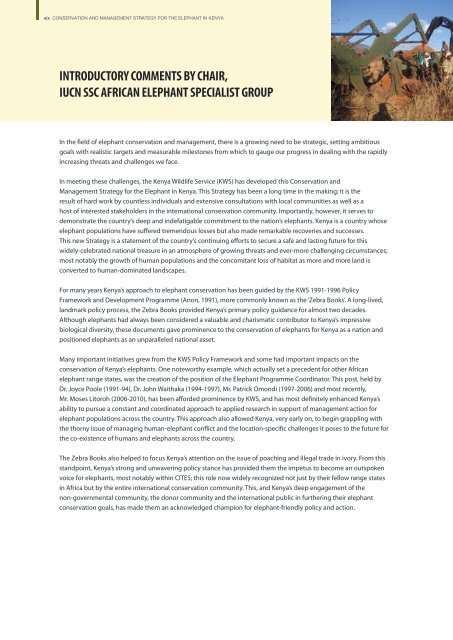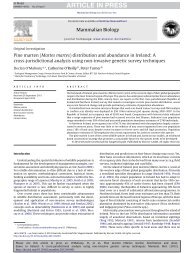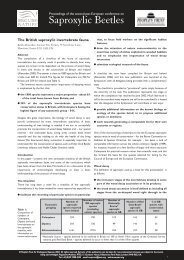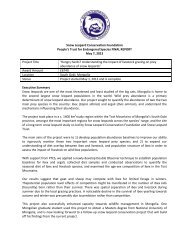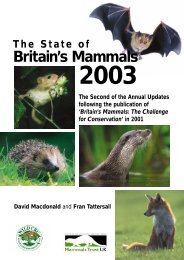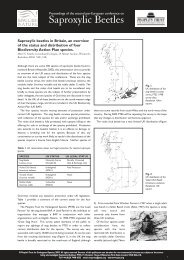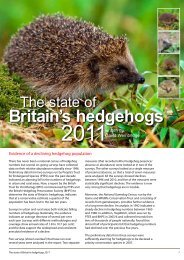National Elephant Strategy - People's Trust for Endangered Species
National Elephant Strategy - People's Trust for Endangered Species
National Elephant Strategy - People's Trust for Endangered Species
You also want an ePaper? Increase the reach of your titles
YUMPU automatically turns print PDFs into web optimized ePapers that Google loves.
xix CONSERVATION AND MANAGEMENT STRATEGY FOR THE ELEPHANT IN KENYAINTRODUCTORY COMMENTS BY CHAIR,IUCN SSC AFRICAN ELEPHANT SPECIALIST GROUPIn the field of elephant conservation and management, there is a growing need to be strategic, setting ambitiousgoals with realistic targets and measurable milestones from which to gauge our progress in dealing with the rapidlyincreasing threats and challenges we face.In meeting these challenges, the Kenya Wildlife Service (KWS) has developed this Conservation andManagement <strong>Strategy</strong> <strong>for</strong> the <strong>Elephant</strong> in Kenya. This <strong>Strategy</strong> has been a long time in the making; it is theresult of hard work by countless individuals and extensive consultations with local communities as well as ahost of interested stakeholders in the international conservation community. Importantly, however, it serves todemonstrate the country’s deep and indefatigable commitment to the nation’s elephants. Kenya is a country whoseelephant populations have suffered tremendous losses but also made remarkable recoveries and successes.This new <strong>Strategy</strong> is a statement of the country’s continuing ef<strong>for</strong>ts to secure a safe and lasting future <strong>for</strong> thiswidely-celebrated national treasure in an atmosphere of growing threats and ever-more challenging circumstances;most notably the growth of human populations and the concomitant loss of habitat as more and more land isconverted to human-dominated landscapes.For many years Kenya’s approach to elephant conservation has been guided by the KWS 1991-1996 PolicyFramework and Development Programme (Anon, 1991), more commonly known as the ‘Zebra Books’. A long-lived,landmark policy process, the Zebra Books provided Kenya’s primary policy guidance <strong>for</strong> almost two decades.Although elephants had always been considered a valuable and charismatic contributor to Kenya’s impressivebiological diversity, these documents gave prominence to the conservation of elephants <strong>for</strong> Kenya as a nation andpositioned elephants as an unparalleled national asset.Many important initiatives grew from the KWS Policy Framework and some had important impacts on theconservation of Kenya’s elephants. One noteworthy example, which actually set a precedent <strong>for</strong> other Africanelephant range states, was the creation of the position of the <strong>Elephant</strong> Programme Coordinator. This post, held byDr. Joyce Poole (1991-94), Dr. John Waithaka (1994-1997), Mr. Patrick Omondi (1997-2006) and most recently,Mr. Moses Litoroh (2006-2010), has been af<strong>for</strong>ded prominence by KWS, and has most definitely enhanced Kenya’sability to pursue a constant and coordinated approach to applied research in support of management action <strong>for</strong>elephant populations across the country. This approach also allowed Kenya, very early on, to begin grappling withthe thorny issue of managing human-elephant conflict and the location-specific challenges it poses to the future <strong>for</strong>the co-existence of humans and elephants across the country.The Zebra Books also helped to focus Kenya’s attention on the issue of poaching and illegal trade in ivory. From thisstandpoint, Kenya’s strong and unwavering policy stance has provided them the impetus to become an outspokenvoice <strong>for</strong> elephants, most notably within CITES; this role now widely recognized not just by their fellow range statesin Africa but by the entire international conservation community. This, and Kenya’s deep engagement of thenon-governmental community, the donor community and the international public in furthering their elephantconservation goals, has made them an acknowledged champion <strong>for</strong> elephant-friendly policy and action.“This new <strong>Strategy</strong> <strong>for</strong> the conservation and management of Kenya’s elephants is both long overdue andall-the-more necessary now than ever be<strong>for</strong>e because despite the continuing recovery of their national herds, thereis no obvious reason <strong>for</strong> complacency. Like all its fellow African elephant range States, Kenya faces serious andgrowing challenges on many fronts. Kenya’s proximity to neighbouring countries at war, and the accompanying andinevitably uncontrollable flow of arms, renders the nation and its elephants at continued risk; all the more worryingin the face of a growing and potentially insatiable demand <strong>for</strong> ivory as a luxury item in emerging economies of theworld. And with Kenya’s steadily growing human population, shrinking areas of arable land, and limited long-termland-use planning at the national level, increasing conflict between the country’s rural communities and itselephants is inevitable. Indeed, a difficult future to navigate.“Conservation and Management <strong>Strategy</strong> <strong>for</strong> the <strong>Elephant</strong> in Kenya (2012 – 2021)” represents the hard work of manydedicated conservation professionals and the voices of many who were given the opportunity to actively participatein its <strong>for</strong>mulation. While it identifies the current threats, it also explores the emerging opportunities and provides aframework <strong>for</strong> coordinated and concerted action over the next ten years to assure the persistence of elephants inKenya, both as an economic asset <strong>for</strong> its national constituency, and as a symbol of Kenya’s deep commitment to theconservation of biodiversity. In joining 10 of their fellow African elephant range states to undertake such a targetedand dedicated planning approach <strong>for</strong> the conservation and management of elephants at the national level, I hopeit will serve as clarion call <strong>for</strong> others to follow suit and a beacon of hope <strong>for</strong> the future of elephants over the comingdecade.Dr. Holly T. Dublin[ TOP ] Plate 14.<strong>Elephant</strong> translocations in Tsavo- Richard Kock[ RIGHT ] Plate 15.This new <strong>Strategy</strong> is a statement of the country’s continuing ef<strong>for</strong>tsto secure a safe and lasting future <strong>for</strong> this widely-celebrated nationaltreasure in an atmosphere of growing threats and ever-morechallenging circumstances; most notably the growth of humanpopulations and the concomitant loss of habitat”Rescuing an orphaned elephantwhose mother was killed bypoachers in north-west Laikipia,- Max Graham, Space <strong>for</strong> GiantsCONSERVATION AND MANAGEMENT STRATEGY FOR THE ELEPHANT IN KENYA xx


